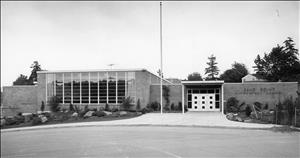This People's History of Sand Point Elementary School is taken from Building for Learning: Seattle Public School Histories, 1862-2000 by Nile Thompson and Carolyn J. Marr. That book, published in 2002 by Seattle Public Schools, compiled profiles of all the public school buildings that had been used by the school district since its formation around 1862. The profiles from the book are being made available as People's Histories on HistoryLink.org courtesy of Seattle Public Schools. It should be noted that these essays are from 2000. Some of the buildings profiled are historic, some of recent vintage, and many no longer exist (new names and buildings not included in these profiles from 2000 have been added), but each plays or has played an important role in the education of Seattle's youth.
Sand Point Elementary
The first school in the Sand Point area opened in 1890. It was named Pontiac School after the community that grew up around the Pontiac Shingle Mill, located on a small cove directly north of Sand Point and south of Matthews Beach.
Pontiac School was located in Yesler School District No. 148. After its annexation into the Seattle School District, the one-room schoolhouse fell into disuse because its 10 students were transported to Yesler School (see Bryant) as a cost-cutting measure. After the school was permanently closed, the site was sold to the federal government as part of the US Naval Air Station.
In early September 1941, Navy-community parents at the Sand Point Housing Project, immediately south of the air station, expressed their dissatisfaction with bus transportation by staging a one-day strike. Of their 51 children, 48 stayed home that day, rather than attend Bryant School. At that time, there were too few students to justify a separate school.
Fifteen years later the situation was entirely different. By then, the Seattle School District's enrollment was second only to Los Angeles in the western states and the district employed more than 531 portable buildings. The elementary schools in the northeast section of the city (Laurelhurst, Bryant, and View Ridge) all had exceeded capacity, so the time had come again for a school in the Sand Point area. Construction funds for new school buildings were desperately needed. In the meantime, the Sand Point students attended a temporary school, which opened in September 1956 in 13 portables.
The property purchased for the new school, located just south of the Sand Point Naval Air Station, had been part of a farm owned by the Ihrig family. A large apple orchard stood directly south of the portable school, which enrolled 309 pupils in grades K-6.
A construction bond issue passed in November 1956 provided the funds for a permanent Sand Point facility. The architects' plans called for 14 classrooms, a gymnasium, cafeteria and kitchen, a book room with audio-visual facilities, administrative offices, and faculty rooms. Additional features included forced hot-water heating and both incandescent and fluorescent lighting. In September 1957, work began on the new building on the site of the old orchard. One year later 13 teachers greeted 407 pupils at the doorways of their new classrooms. A few weeks later, one more teacher joined the staff and every classroom was in use.
The student body began changing in 1965 when Central Area students came to Sand Point as part of the Voluntary Transfer Program. Under this program, 51 pupils from Harrison and 13 from Madrona attended during the 1967-68 school year.
In 1967, Sand Point received a collection of 30 original paintings by well-known Northwest artists. Mr. and Mrs. Angus Mallory, whose grandchildren attended the school, donated the frames. A follow-up gift of over 550 more artworks circulated among all Seattle schools.
In 1971, the school became K-5 when the sixth graders left for middle schools. A program for children with learning-language disabilities began the same year, and a preschool rented one of the school's vacant rooms.
Sand Point's enrollment dropped to 176 in September 1979, so the principal of Sacajawea took over as head of both schools. In a school district plan released that year, Sand Point was designated for closure. Citizens opposed the possible closure, citing its relatively new facility, low maintenance costs, and success in voluntary desegregation. The school had a minority enrollment of 38 percent. University of Washington students whose children attended Sand Point petitioned both the district and the university to retain the school. When it finally closed in 1988, Sand Point was operating at only 56 percent of capacity. In its final years, the school housed the Deaf and Hard-of-Hearing program.
Since 1990, the building has been leased to North Seattle Community College for off-campus classrooms.
Details:
Name: Pontiac School
Location: 60th Avenue NE & Sand Point Way
Building: 1-room wood
Architect: n.a.
Site: 1.003 acres
1890: Opened by Yesler School District
1911: Annexed into Seattle School District
1918: Closed
1926: Sold
Name: Sand Point Elementary School
Location: 6208 60th Avenue NE
Building: 14-room brick veneer with steel frame
Architect: G. Stoddard-F. Huggard & Associates
Site: 4.08 acres
1957: Named on February 15
1958: Opened in September
1988: Closed in June
1990: Leased to North Seattle Community College
Seattle Public Schools, 1862-2000: Sand Point Elementary School
- Posted 9/12/2013
- HistoryLink.org Essay 10587
Sources:
Nile Thompson and Carolyn J. Marr, Building for Learning: Seattle Public School Histories, 1862-2000 (Seattle: Seattle Public Schools, 2002).
Licensing: This essay is licensed under a Creative Commons license that encourages reproduction with attribution. Credit should be given to both HistoryLink.org and to the author, and sources must be included with any reproduction. Click the icon for more info. Please note that this Creative Commons license applies to text only, and not to images. For more information regarding individual photos or images, please contact the source noted in the image credit.

